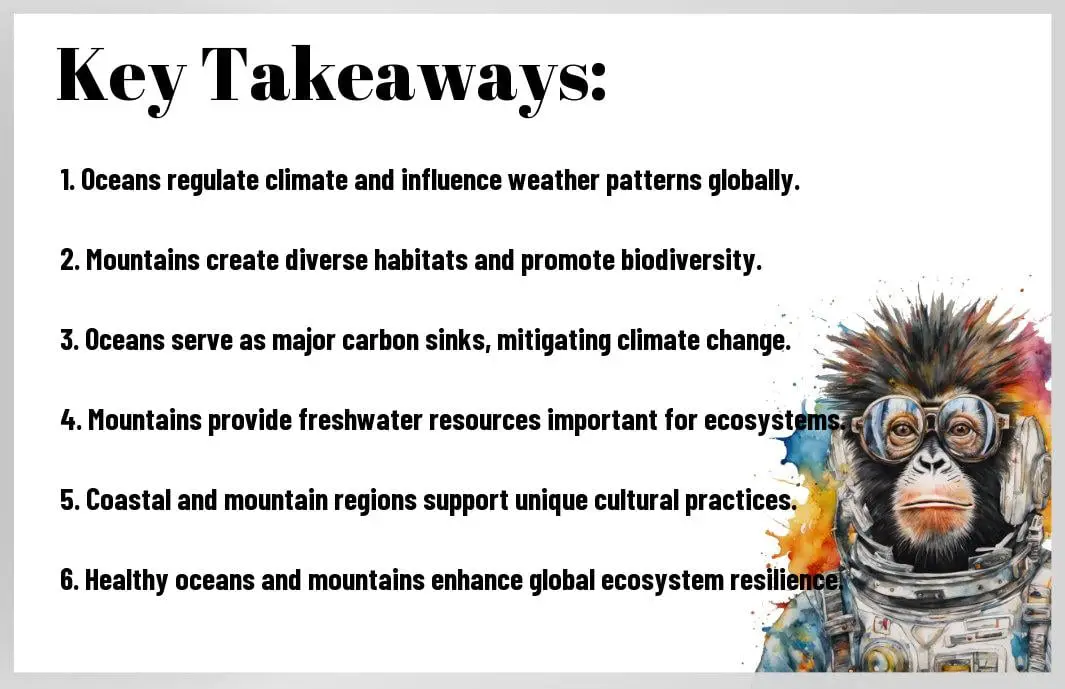Most people underestimate the critical role that oceans and mountains play in maintaining the delicate balance of our global ecosystems. As you explore this topic, you will discover how these two geographical features influence climate, biodiversity, and human livelihoods. From regulating weather patterns to supporting a vast array of flora and fauna, understanding their significance is imperative for appreciating the intricate connections that sustain life on Earth. By delving into the dynamics of oceans and mountains, you can gain valuable insights into the challenges they face and how they shape your world.
Key Takeaways:
- Oceans: Cover over 70% of the Earth’s surface, playing a crucial role in regulating the global climate and storing heat.
- Biodiversity: Oceans and mountains are vital habitats that support diverse ecosystems, providing homes for countless species.
- Water Cycle: Oceans are integral to the water cycle, influencing precipitation patterns and freshwater availability across the globe.
- Mountain Ecosystems: Mountains create unique habitats and microclimates, contributing to regional biodiversity and acting as important sources of freshwater.
- Human Impact: Climate change and pollution threaten the health of oceans and mountains, highlighting the need for conservation efforts to preserve these critical ecosystems.

The Role of Oceans in Global Ecosystems
Before submerging into the specifics of how oceans function within global ecosystems, it’s vital to understand that these vast bodies of water cover about 71% of the Earth’s surface and are crucial for sustaining life. Oceans not only provide habitat for countless species but also play a pivotal role in regulating climate and supporting human activities. Their influence extends far beyond their shores, touching on aspects of weather patterns, food supply, and even the air we breathe.
Ocean Currents and Climate Regulation
On a global scale, ocean currents serve as a powerful mechanism for climate regulation. These currents operate much like rivers within the ocean, moving warm and cold water across vast distances, which helps to moderate temperatures around the world. When warm water from the equator travels to the poles, it can raise local temperatures and help maintain climatic stability. This intricate balance contributes significantly to weather patterns, influencing rainfall and the occurrence of storms, ultimately affecting agricultural practices that are vital for food security.
In addition to stabilizing temperatures, the interaction between ocean currents and atmospheric conditions facilitates the distribution of nutrients and gases, such as oxygen and carbon dioxide. This process is imperative not only for the health of marine life but also for maintaining the overall health of our planet. You can see how disruptions in these currents due to climate change can have serious implications, affecting everything from sea levels to weather variability and, by extension, global ecosystems.
Biodiversity in Marine Environments
Marine ecosystems are rich with biodiversity, offering a complex web of life that ranges from the smallest plankton to the largest whales. Marine environments, including coral reefs, deep-sea habitats, and coastal regions, host a vast array of species, many of which are yet to be discovered. This biodiversity is crucial because it supports ecosystem resilience, enabling marine communities to adapt to changing environmental conditions and disturbances.
Biodiversity plays a critical role not just in preserving ecological balance, but it also enhances the productivity of these ecosystems. As you explore the oceans, you’ll learn that diverse species interact in various ways, including predator-prey relationships, symbiotic partnerships, and competition, all of which contribute to a healthy oceanic environment. The loss of biodiversity can weaken these interactions, leading to collapsed fish populations and degraded habitats.
The Carbon Cycle and Oceans
Carbon is a fundamental element for life, and oceans are integral to the global carbon cycle. The oceans act as significant carbon sinks, absorbing a large portion of carbon dioxide emitted into the atmosphere. As you research deeper into this process, you’ll recognize that marine plants, especially phytoplankton, play a vital role in sequestering carbon through photosynthesis. This not only helps mitigate climate change but also supports the marine food chain.
For instance, the role of oceans as carbon sinks helps to buffer the effects of climate change by storing carbon dioxide long-term, thus reducing atmospheric concentrations. This process requires a careful balance, as increased CO2 levels can lead to ocean acidification, which threatens marine life and disrupts ecosystems. Your understanding of this dynamic highlights the importance of protecting oceanic health to maintain both biodiversity and climate stability.
Oceans as Nutrient Reservoirs
Role as nutrient reservoirs is another imperative function of oceans. They are teeming with imperative nutrients, such as nitrogen and phosphorus, that are critical for the growth of marine organisms. The mixing of ocean waters through currents and upwelling processes brings these nutrients from the depths of the ocean to the surface, providing the foundation for productive marine ecosystems where fish and other sea creatures thrive.
Oceans are also responsible for supplying nutrients that support global fisheries, playing a significant role in feeding billions of people worldwide. It’s important to consider how human activities, such as pollution and overfishing, can disrupt this delicate balance. By understanding the vital functions that oceans play as nutrient reservoirs, you can appreciate the need for sustainable practices that protect these resources for future generations.
Oceans hold an incredible wealth of nutrients that support diverse marine ecosystems. It is crucial for you to recognize how the health of oceans directly impacts fisheries and the global food supply. Preserving this vital nutrient reservoir can ensure that future generations can continue to rely on oceans for their sustenance and ecological stability.

The Significance of Mountains in Ecosystems
Now, let’s explore the vital role mountains play in shaping global ecosystems. Mountains are not merely towering structures; they influence climate, support diverse wildlife, and contribute significantly to water resources. Understanding this significance can enhance your appreciation for these natural landmarks and their ecological importance.
Mountain Ranges and Weather Patterns
On many occasions, you’ve probably noticed how mountain ranges create distinct weather patterns. As moist air approaches a mountain, it is forced to rise, which cools the air, causing precipitation on the windward side. This climatic phenomenon leads to lush, green landscapes that nurture various flora and fauna. Conversely, the leeward side often experiences a rain shadow effect, resulting in arid conditions that can drastically alter the ecosystem.
This interplay between mountains and weather has far-reaching implications. You might realize that areas near mountain ranges can experience significant temperature fluctuations and varying ecosystems within close proximity to each other. Such dynamics are crucial for sustaining different habitats, making these regions pivotal for biodiversity and resource distribution.
Biodiversity in Alpine Regions
Ranges of mountains are home to unique alpine ecosystems that harbor an impressive array of biodiversity. You may find that these ecosystems are marked by a variety of plants and animal species that have adapted to the harsh conditions of high altitudes, including extreme temperatures and limited oxygen. Such adaptations often lead to high levels of endemism, where species are specially evolved to thrive in these environments.
Mountains serve as significant refuges for plant and animal species that are unable to survive in flatter, more homogenized landscapes. If you investigate into alpine regions, you will discover that these areas not only shelter endemic species but also function as vital corridors for wildlife migration, notably as temperatures rise due to climate change. The health and preservation of these mountain ecosystems are crucial for maintaining global biodiversity.
Water Resources and Watersheds
Ranges are instrumental in capturing and storing water, acting as natural watersheds that supply freshwater to millions of people across the globe. As precipitation falls on these mountain ranges, it collects and feeds rivers, lakes, and reservoirs that are vital for agriculture, domestic use, and industrial activities. This role is particularly vital in regions that rely heavily on meltwater from glaciers and snowpack, especially during dry seasons.
Weather patterns around mountains profoundly influence when and how much water is available throughout the year. You should note that changes in climate can significantly alter the balance of these water resources, potentially leading to droughts or flooding that affect both human communities and surrounding ecosystems. Therefore, recognizing the connection between mountains and water resources is vital for effective conservation and management strategies.
Mountains as Natural Barriers
The towering presence of mountains can act as natural barriers that influence the distribution of species, climate, and even human activities. As you examine different regions, you will find that mountains can restrict animal movement, creating isolated populations that may evolve independently over time. This isolation can lead to greater species diversity but can also threaten species unable to traverse these barriers.
Another aspect to consider is how mountains can influence cultural and political boundaries. Historically, societies have developed distinct identities based on the isolation and protection that mountain ranges provide. As you explore different regions, you may recognize how these natural barriers have shaped economies and interactions between different human populations, highlighting the interconnectedness between mountains and human endeavors.
Interconnectedness of Oceans and Mountains
Unlike many may perceive, oceans and mountains are not isolated entities but are deeply interconnected, influencing each other in multiple ways. This relationship plays a crucial role in shaping global ecosystems and climate. For instance, mountain ranges can affect weather patterns and, subsequently, ocean currents, creating a dynamic interplay that supports or hinders various forms of life. As you explore this intricate connection, you’ll find that understanding it is vital for appreciating the broader ecological picture.
Impact of Mountain Ranges on Ocean Currents
An necessary aspect of the relationship between oceans and mountains lies in the way mountain ranges can alter ocean currents. When winds move over mountainous terrain, they can create patterns of air flow that influence ocean temperatures and currents far from the coast. Elevated areas can redirect prevailing winds, causing them to gain or lose moisture, which ultimately affects ocean circulation. This phenomenon impacts not only the weather in coastal areas but also the climate patterns experienced by regions thousands of miles away, demonstrating the far-reaching effects of your local mountains.
Moreover, the physical presence of mountains can lead to the formation of upwelling zones in oceans. These zones, where deeper waters rise to the surface, are often rich in nutrients and support diverse marine ecosystems. By affecting ocean temperatures and nutrient distribution, mountain ranges play a pivotal role in sustaining fisheries and marine biodiversity, thus underlining their importance in any discussion about global ecosystems.
Coastal Ecosystems and Mountain Influence
One of the most fascinating aspects of the interconnectedness between oceans and mountains is their collective impact on coastal ecosystems. Coastal areas serve as a meeting point for terrestrial and marine environments, and mountains often influence what happens in these regions. For example, the erosion of mountains can result in sediment runoff, enriching coastal waters with nutrients that stimulate the growth of marine phytoplankton. This, in turn, forms the foundation of the oceanic food web, greatly affecting the health of various coastal ecosystems.
Plus, mountains can also act as barriers against certain weather events, protecting coastal habitats from extreme conditions. The vegetation that grows on mountains captures rainwater and regulates flow into rivers and streams that feed into the ocean. This process ensures a consistent and balanced supply of freshwater, which is necessary for sustaining marine life. Your understanding of these coastal dynamics will enhance your appreciation for the complexities of ecosystems and the significance of both oceans and mountains.
Ecological Significance of River Systems
Ocean currents are instrumental in regulating the Earth’s climate, and their formation is often influenced by freshwater systems that originate in mountain ranges. Rivers flowing from the mountains to the ocean carry not only nutrients but also sediments and pollutants, which can significantly impact coastal water quality and marine habitats. This relationship highlights how the health of river systems downstream is intrinsically linked to the health of ocean ecosystems. You can see how vital it is to protect both mountains and rivers, as their collective well-being directly supports marine life.
Another critical factor is the role of river systems in supporting biodiversity. Riverine ecosystems often serve as migration paths for various aquatic species, including fish that depend on these freshwater sources for spawning. Consequently, when you consider the ecological health of oceans, it is crucial to also take into account the mountains that feed into rivers, as they create a symbiotic relationship that sustains life both in freshwater and marine environments.

Human Impact on Oceanic and Mountain Ecosystems
For many years, human activities have significantly altered the natural state of both oceanic and mountain ecosystems. These remarkable environments, which serve as critical habitats for countless species and provide crucial resources for humanity, are now facing unprecedented threats. Understanding the depth of our impact is crucial if you are to engage in conservation efforts and ensure a sustainable future for these invaluable ecosystems.
Overfishing and Ocean Degradation
Impact from overfishing has wreaked havoc on oceanic ecosystems, leading to the decline of numerous fish populations and the destabilization of marine food webs. As a result, the delicate balance of these underwater environments is disrupted, making it increasingly difficult for species to recover. You may not realize that this overexploitation of marine resources not only affects fish but also threatens other organisms that rely on them, including seabirds, marine mammals, and even the coral reefs that can be destroyed due to changes in water quality.
Moreover, ocean degradation extends beyond overfishing to include pollution, habitat destruction, and the effects of climate change. If you consider the cumulative effects of all these factors, it becomes clear that your actions — from the products you consume to the waste you generate — have a significant impact on the health of our oceans. By embracing sustainable fishing practices and supporting initiatives to protect marine environments, you can play a foundational role in restoring and preserving these critical ecosystems for future generations.
Deforestation and Mountain Ecosystems
With the rapid pace of deforestation, mountain ecosystems are undergoing drastic changes that threaten their biodiversity and resilience. When forests are cleared for agricultural expansion, urban development, or logging, you will observe the loss of not only trees but also the rich variety of plants and animals that inhabit these areas. This disruption causes soil erosion, increased runoff, and altered watershed dynamics, which contribute further to the degradation of mountain habitats.
In addition to direct habitat loss, the fragmentation of these ecosystems leads to isolation for many species, making it difficult for them to find mates or migrate in search of food. You might find this alarming, as these mountain habitats are often home to unique species that cannot be found anywhere else. As these forests continue to vanish, the long-term consequences for the environment and local communities become increasingly significant, emphasizing the need for responsible land-use practices and reforestation efforts.
Ecosystems that thrive in mountainous regions are particularly sensitive to changes in their surroundings. They play critical roles in carbon sequestration, water supply regulation, and biodiversity preservation. Your recognition and support for conservation initiatives focused on protecting these areas can significantly contribute to the maintenance and restoration of ecosystem functionality and resilience, crucial for mitigating the impacts of both climate change and human activity.
Climate Change and Its Effects on Oceans and Mountains
To understand the effects of climate change on oceans and mountains, you must consider the escalating temperatures, rising sea levels, and changing precipitation patterns. These shifts create new challenges for marine and terrestrial habitats, impacting both the species that live there and the human communities that depend on these ecosystems for their livelihoods. Ocean acidification, resulting from increased carbon dioxide emissions, poses a grave threat to coral reefs and the diverse marine life they support, while mountainous regions face the melting of glaciers and altered water availability, challenging local agriculture and drinking water supplies.
The consequences of such changes are far-reaching. For instance, you might notice the migration patterns of fish changing as ocean temperatures rise, while mountain species struggle to adapt to shifting climates. This illustrates how interconnected these systems are, and your actions in mitigating climate change, such as reducing your carbon footprint and advocating for sustainable practices, are crucial for the health of oceans and mountains alike.
Effects of climate change are not only environmental; they also have profound implications for social systems dependent on these ecosystems. Communities relying on fishing or mountain resources for their livelihoods face uncertainty and potential loss of income. By nurturing sustainable practices and supporting policies that address climate change, you can help safeguard both oceanic and mountain ecosystems, ensuring their vitality and resilience for the generations that follow.

Conservation Efforts for Oceans and Mountains
All around the globe, conservation efforts are crucial for maintaining the health of our oceans and mountains. These natural environments not only support biodiversity but also dramatically influence climate and weather patterns. For a deeper understanding of the intricate dynamics of our oceans, you can explore resources like Ocean 101 | U.S. Geological Survey. This resource offers foundational knowledge on ocean science and emphasizes the importance of protecting these vital ecosystems.
Marine Protected Areas
Areas designated as Marine Protected Areas (MPAs) are vital in the fight against the degradation of ocean ecosystems. These areas restrict human activities such as fishing, oil drilling, and shipping, allowing marine life to thrive without interference. By establishing MPAs, you help protect crucial habitats, including coral reefs and migratory routes for various marine species. The successful implementation of these protected areas can lead to the recovery of overfished populations and contribute to the overall health of the ocean.
In addition to their conservation benefits, MPAs also serve as natural laboratories for scientists. Here, you can observe the effects of reduced human activity on marine ecosystems and gather vital data that informs future conservation strategies. Collaborative efforts involving local communities, governments, and scientific organizations are paramount to the effective management of MPAs, ensuring they fulfill their purpose effectively.
Sustainable Mountain Practices
Practices that prioritize sustainability in mountainous regions considerably impact biodiversity and ecosystem health. In your own travels or local engagements, you might come across sustainable logging techniques, responsible tourism, and conservation-focused agricultural practices that minimize environmental harm. Such initiatives not only promote ecosystem resilience but also maintain the social and economic welfare of mountain communities that depend on these resources.
Efforts to align mountain activities with sustainable practices can yield significant benefits, such as reduced erosion, improved water quality, and increased habitat for wildlife. Organizations and communities worldwide are experimenting with regenerative land-use practices that restore soil health, enhance biodiversity, and create a balance between human needs and environmental integrity. By participating in or supporting these initiatives, you contribute to a more sustainable future for mountain ecosystems.
Collaborations for Ecosystem Preservation
Oceans and mountains are intricately connected to a wider network of ecosystems, making collaborations for their preservation vital. Partnerships among local communities, governmental bodies, and international organizations are vital for creating effective conservation strategies that consider the unique needs of each ecosystem. By working together, these groups can develop policies that promote sustainable practices, raise public awareness, and secure funding for conservation projects.
The importance of ongoing dialogue and cooperation cannot be overstated. Mountain ecosystems benefit from shared knowledge and innovative practices in conservation, while marine ecosystems gain resilience through cooperative management. By fostering these collaborations, you are actively participating in a larger movement towards protecting our planet’s critical natural resources.
Mountain ecosystems, much like marine environments, hold intrinsic value. When you support collaborative efforts aimed at preserving these ecosystems, you are contributing to not only the well-being of the biodiversity they harbor but also the health of the planet as a whole. Your involvement, whether through advocacy, education, or practical initiatives, can drive meaningful change in the conservation landscape.
Future Implications for Oceans and Mountains
Keep in mind that the future of our oceans and mountains is heavily interlinked with human activities and global policy decisions. As you explore the various changes anticipated in these crucial ecosystems, you’ll gain a clearer perspective on how they will influence not only the environment but also your own life and the lives of future generations. Understanding these implications can empower you to make informed decisions and advocate for sustainable practices that protect these irreplaceable natural resources.
Predictions for Marine Life
Life in the oceans is expected to undergo significant transformations as climate change continues to impact marine ecosystems. You might be aware that rising ocean temperatures are leading to coral bleaching, which threatens biodiversity and the livelihoods of communities dependent on these ecosystems. Additionally, shifting oceanic currents and changing salinity levels can disrupt the migration patterns of fish, impacting food security worldwide. As you consider these changes, it’s important to recognize that the implications of altered marine life extend beyond the aquatic environment, potentially affecting terrestrial ecosystems as well.
The Role of Technology in Conservation
Marine technology plays a crucial role in the conservation of our oceans and mountains, providing innovative solutions to long-standing challenges. You should take note of advancements in monitoring systems, such as satellite imagery and underwater drones, which allow scientists to track changes in ocean health and mountain ecosystems more effectively. These technologies can help you stay informed about the state of the environments you’re passionate about and aid in the development of strategic conservation efforts.
It is necessary to leverage these technological advancements to enhance research capabilities, providing new insights into biodiversity and the impacts of human interventions. By integrating technology with community engagement, you have the ability to promote awareness and foster a collective effort towards preserving the delicate balance of marine and mountainous ecosystems. Through your involvement and understanding of these technologies, you can also contribute to solutions aimed at mitigating the effects of climate change and protecting natural habitats.
Impact of Global Policy Changes
Implications for oceans and mountains become particularly significant when we consider global policy changes aimed at climate adaptation and environmental conservation. As you become aware of these evolving policies, you can better understand how they will influence ecological stability, sustainable resource management, and even your own daily choices. Policies that promote conservation can enhance your connection to nature while advocating for a healthier planet. Your participation in discussions about such policies can help shape a sustainable future.
Another aspect to consider is that international agreements and national regulations can expedite efforts to combat environmental degradation. As more nations collaborate to prioritize the protection of marine and mountain ecosystems, you can expect the establishment of marine protected areas and conservation funds aimed at restoring biodiversity. An informed and actively engaged public is vital for both the creation and support of these policies, making your voice necessary in advocating for the future of these critical ecosystems.
To wrap up
The significance of oceans and mountains in global ecosystems cannot be overstated, as they play pivotal roles in maintaining environmental balance and supporting biodiversity. Oceans, covering over 70% of the Earth’s surface, act as vast reservoirs of resources, regulate climate patterns, and are crucial for carbon cycling. Your understanding of the intricate relationships within these marine ecosystems can enhance your appreciation for their conservation, which is vital for the health of our planet. Similarly, mountains contribute to climatic variation, sustain freshwater sources, and serve as unique habitats for countless species. Recognizing the influence of these geographical features allows you to connect more deeply with the natural world and understand the critical challenges posed by climate change and habitat destruction.
By exploring the importance of oceans and mountains, you empower yourself to become an informed advocate for environmental stewardship. Whether it is through supporting initiatives that protect marine life or promoting sustainable development in mountain regions, your actions can significantly impact the preservation of these vital ecosystems. Stay engaged, share your knowledge, and inspire others to appreciate the interconnectedness of our planet’s geography, ultimately fostering a collective responsibility toward environmental protection and sustainability for future generations.







